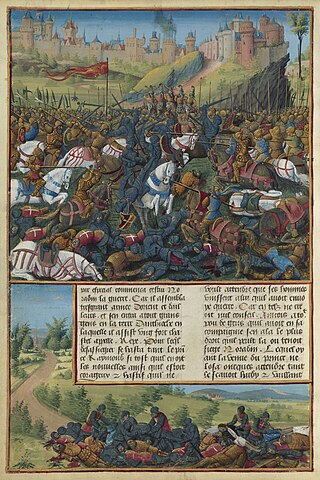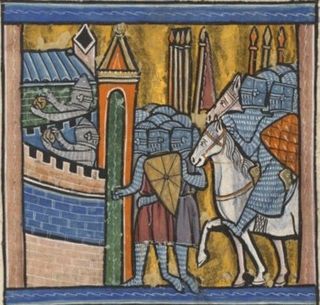
The First Crusade (1096–1099) was the first of a series of religious wars, or Crusades, initiated, supported and at times directed by the Latin Church in the middle ages. The objective was the recovery of the Holy Land from Islamic rule. While Jerusalem had been under Muslim rule for hundreds of years, by the 11th century the Seljuk takeover of the region threatened local Christian populations, pilgrimages from the West, and the Byzantine Empire itself. The earliest initiative for the First Crusade began in 1095 when Byzantine emperor Alexios I Komnenos requested military support from the Council of Piacenza in the empire's conflict with the Seljuk-led Turks. This was followed later in the year by the Council of Clermont, during which Pope Urban II supported the Byzantine request for military assistance and also urged faithful Christians to undertake an armed pilgrimage to Jerusalem.

The Second Crusade (1147–1150) was the second major crusade launched from Europe. The Second Crusade was started in response to the fall of the County of Edessa in 1144 to the forces of Zengi. The county had been founded during the First Crusade (1096–1099) by King Baldwin I of Jerusalem in 1098. While it was the first Crusader state to be founded, it was also the first to fall.

Hugh I succeeded to the throne of Cyprus on 1 April 1205 underage upon the death of his elderly father Aimery, King of Cyprus and Jerusalem. His mother was Eschiva of Ibelin, heiress of that branch of Ibelins who had held Bethsan and Ramleh.

Hugh IV of Burgundy was Duke of Burgundy between 1218 and 1272 and from 1266 until his death was titular King of Thessalonica. Hugh was the son of Odo III, Duke of Burgundy and Alice de Vergy.

The siege of Nicaea was the first major battle of the First Crusade, taking place from 14 May to 19 June 1097. The city was under the control of the Seljuk Turks who opted to surrender to the Byzantines in fear of the crusaders breaking into the city. The siege was followed by the Battle of Dorylaeum and the Siege of Antioch, all taking place in modern Turkey.
Norman Housley is a professor emeritus of History at the University of Leicester.

The Crusades were a series of religious wars initiated, supported, and sometimes directed by the Christian Latin Church in the medieval period. The best known of these military expeditions are those to the Holy Land in the period between 1095 and 1291 that had the objective of reconquering Jerusalem and its surrounding area from Muslim rule after the region had been conquered by the Rashidun Caliphate centuries earlier. Beginning with the First Crusade, which resulted in the conquest of Jerusalem in 1099, dozens of military campaigns were organised, providing a focal point of European history for centuries. Crusading declined rapidly after the 15th century.

The Byzantine–Seljuk wars were a series of conflicts in the Middle Ages between the Byzantine Empire and the Seljuk Empire. They shifted the balance of power in Asia Minor and Syria from the Byzantines to the Seljuk dynasty. Riding from the steppes of Central Asia, the Seljuks replicated tactics practiced by the Huns hundreds of years earlier against a similar Roman opponent but now combining it with new-found Islamic zeal. In many ways, the Seljuk resumed the conquests of the Muslims in the Byzantine–Arab Wars initiated by the Rashidun, Umayyad and Abbasid Caliphates in the Levant, North Africa and Asia Minor.

Jerusalem in the Middle Ages was a major Byzantine metropolis from the 4th century CE before the advent on the early Islamic period in the 7th century saw it become the regional capital of Jund Filastin under successive caliphates. In the later Islamic period it went on to experience a period of more contested ownership, war and decline. Muslim rule was interrupted for a period of about 200 years by the Crusades and the establishment of the Christian Kingdom of Jerusalem. At the tail end of the Medieval period, the city was ceded to the Ottomans in 1517, who maintained control of it until the British took it in 1917.

The Frankokratia, also known as Latinokratia and, for the Venetian domains, Venetokratia or Enetokratia, was the period in Greek history after the Fourth Crusade (1204), when a number of primarily French and Italian states were established by the Partitio terrarum imperii Romaniae on the territory of the dissolved Byzantine Empire.

Samagar, also Cemakar, was a Mongol general of the Il-Khan ruler Abaqa Khan (1234–1282), mentioned as leading a Mongol invasion force in 1271, in attempted coordination with the Ninth Crusade.

The historiography of the Crusades is the study of history-writing and the written history, especially as an academic discipline, regarding the military expeditions initially undertaken by European Christians in the 11th, 12th, or 13th centuries to the Holy Land. This scope was later extended to include other campaigns initiated, supported, and sometimes directed by the Roman Catholic Church. The subject has involved competing and evolving interpretations since the capture of Jerusalem in 1099 until the present day. The religious idealism, use of martial force and pragmatic compromises made by those involved in crusading were controversial, both at the time and subsequently. Crusading was integral to Western European culture, with the ideas that shaped behaviour in the Late Middle Ages retaining currency beyond the 15th century in attitude rather than action.
Historians and histories of the Crusades identifies the sets of histories and their authors concerning the Crusades that were conducted from 1095 through the 16th century. Reflecting what Crusader historians have typically considered, works written as early as the 4th century may also be relevant, particularly in the history of the Holy Land and Christian pilgrimages. This discussion is divided into the following eight parts:
The Wisconsin Collaborative History of the Crusades is a six-volume set on the Crusades through the 16th century, published from 1969 to 1989. The work was a major collaborative effort under the general editorship of American medieval historian Kenneth M. Setton. Begun at the University of Pennsylvania in 1950, the work was finished at the University of Wisconsin, and is generally known as the Wisconsin History. Setton oversaw the work of over sixty specialists, covering 98 topics on the full gamut of Crusader studies, reflecting of the concurrent state of the knowledge, with timelines, gazetteers and indexes. The work may be today regarded as uneven in parts and at times dated, but remains as an important resource in the study of the various aspects of crusading history, with fine maps, bibliographies and toponymic details.
The chronology of the later Crusades through 1400 provides a detailed timeline of the Crusades from after the Eighth Crusade, the last of the major expeditions to the Holy Land through the end of the 14th century. This includes the events from 1270 on that led to the Fall of Outremer in 1291 and the Crusades after Acre, 1291–1399.
The chronology of the Crusades after 1400 provides a detailed timeline of the Crusades and considers the Crusades of the 15th century. This continues the chronology of the later Crusades through 1400. In the Middle East, the threats to the Christian West were from the Mamluks, the Timurids and the Ottomans. The latter would also threaten Eastern Europe and would emerge as the primary Islamic dynasty opposing the West. The Byzantine Empire would no longer exist, but the Reconquista was working well and would be resolved by the end of the 15th century. The works of Norman Housley, in particular, describe the Crusading movement in this timeframe, the impact of the fall of Constantinople in 1453, and the manifestation of Crusading propaganda.
Chronologies of the Crusades presents the list of chronologies and timelines concerning the Crusades. These include the Crusades to the Holy Land, the Fall of Outremer, the Crusades after Acre, 1291–1399, the Crusades of the 15th Century, the Northern Crusades, Crusades against Christians, the Popular Crusades and the Reconquista.
A History of the Crusades: list of contributions provides the collected works that appear in the six-volume set A History of the Crusades, edited by Kenneth M. Setton. Published by the University of Wisconsin Press, it is also known as the Wisconsin Collaborative History of the Crusades. The volumes were published from 1969–1989 and consists of 89 chapters covering nearly 5000 pages. Written by 64 prominent historians, it is one of the most important books on the Crusades.